
Scroll Down To Order
Scroll Down To Order
A flicker of hope
is all that stood
. . . against barbarism.
Another outbreak of such a crisis of madness
[meaning the First World War]
would necessarily involve the destruction of
society in the public order. June 1, 1933
People cried out
for a better future.
Germany neither intends nor wishes
to interfere in the internal affairs
of Austria or to conclude an Anschluss. May 1935
If the problem is solved,
there will be no further territorial damands
in Europe by Germany. Sep 1938
CASTLES OF THE MIND ... VENTURE ACROSS ALL BRIDGES
The Contribution of the American Woman during the Emergency
Getting to know how life was on the Home Front is easy. Doing your part was the always important theme of World War II, and never was it as implicitly important as in the Home Front. Doing your part meant anyone, male or female. Allied victory was anchored on American help. The pictures attached to this web page are both in bw and color. It would be a mistake to say WW II was extensively recorded in color; it was not. Yet, it would be an equal mistake to neglect the fine photography of the era. World War Two represents the continuous saga of liberty, whether it be doing your part in a factory or on some far-flung outpost in the tropics or in Alaska. Thousands of women, however, flocked to Portland, Detroit, Buffalo, Bridgeport, Mobile and 135 other war production centers to do their part.
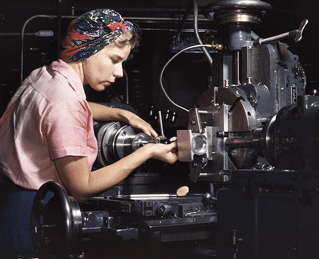



Doing your part was the always important theme of World War II. The zenith of liberation, what people all over the world waited for, took place during 9 crucial months of the Second World War, from June 1944 to Feb. 1945. Those were the harshest, toughest months where in reality, the greatest percent of liberation for people in relation to the cost in lives paid by the so-called greatest generation went beyond the embryonic stage; in particular summer of 1944. Next to the poster is an Afro-American plant worker at the Vultee Aircraft factory drilling on a dive-bomber in Nashville, Tennessee. Notice the bandanna, that was standard for war workers. Black workers experienced discrimination but also volunteered in large numbers, and in many places outside the South, segregation and discrimination were virtually non-existent.
Nine months may not seem a whole lot, but it represented the saga of liberty in cry and pain as the essence of liberty and freedom arcked across many foreign lands. Mind you, a large part was in Europe. It does not mean the sparks of liberty did not exist elsewhere before or since, but the flow reached maximum across every continent save Antarctica.
In the dynamic endeavor, the American woman participated in practically every kind of job, although more than 50% of the women work force were full-time housewives (homemakers if you use the language au courant.) Most women workers were single, before 1944. Thereafter, the shortage grew so acute by 1945, 75% of women workers were married. Most did not have kids, yet.

Women welders on the job. Rosie the Riveter poster, a cultural icon. Every conceivable type of job was offered and taken by the middle of WW II, from search-light missions to driving or ferrying all manner of vehicles.

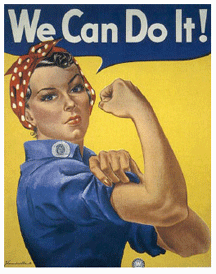

Contrary to popular belief, not all women war-workers were in their early twenties; many were but, there was quite a number in their thirties. When the United States entered the war, there were 13,960,000 women workers. At the end of the war, the number employed in industry shot up to 19,240,000—most dumping mediocre low-paying jobs and taking advantage in defense plants. They literally became highly trained in all manner of defense plants. They were determined that their country did not falter. The range of Home Front life was shown in this 1944 Home Front epic Since You Went Away, an Academy Award winner.
The cities, centers of production, needed women.
Pictured below, countless unsung heroines did the best they could in this case (in pink) electrical assembly and installation at a plant in Long Beach, California, inside the Douglas Aircraft factory. During the expansion, more than 210,000 women were permanently disabled in wartime factory accidents, and most books do not tell you that. Beside her is railroad worker Mrs. Elibia Siematter during her lunch break in Clinton, Iowa. She worked as a sweeper on the Chicago and Northwestern Railroad.
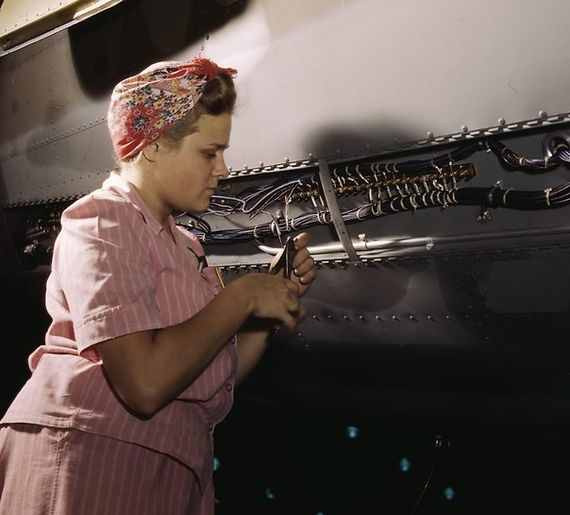

During 1943-45, war impacted cities overflowed with women. Rita Rodriguez is operating her equipment that helped manufacture aircraft at the Consolidated Aircraft plant in Forth Worth, Texas.
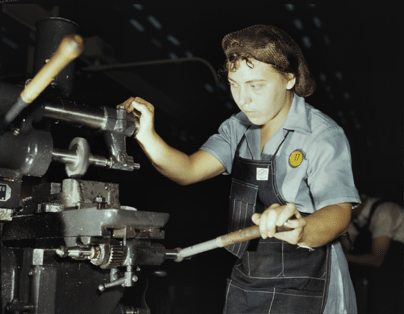
A close-up of two home-front workers assembling a section of a wing for a P-51 Mustang. These P-51s were one of the best fighter aircraft produced in WW II. Some say the best. The women are employees of North American Aviation.

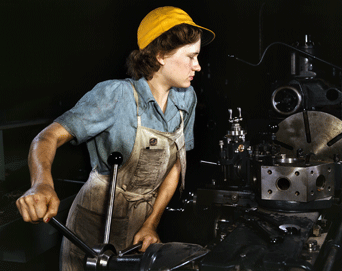

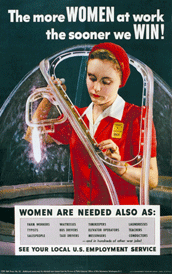

In addition to women leaving for war-jobs, white- or blue-collar (ie. Department stores, or bus drivers), there were thousands who joined some branch of the uniformed-services. Several American women were captured early in the war, including 11 Navy Nurses and 67 Army Nurses in the Philippines and interned as prisoners of war. I will list all the services they served here, which totaled nearly 350,000. To your right is war correspondent Dot Avery.
The American WACS
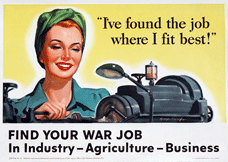

The most widely known is certainly, the Women’s Army Corps. The WW II Army WACS.
They wore olive-green and khaki—even their undies conformed to camouflage standards—they were in every World War Theatre of Operation; from North Africa to Europe to the Pacific and Asia. WACS were first called WAACS (the extra A for Auxiliary). Established in 1942, by the year 1943, it did become regular U.S. Army, complete with strict inspections, KP, duffle bags etc.—sorry folks, they did no 20 mile hikes with 50 pound packs!
WACS were inducted at mass swearing-in ceremonies; WAACS had none. WAACS were not in the U.S. Army. WAACS failed to provide overseas pay, government life insurance, veterans medical coverage, and death benefits granted Regular Army soldiers. The U.S. Army blew it when the WAACS were disbanded and were formed into the WACS. About 15,000 chose not to “re-enlist” and chose to go work in the war factories where the pay was better.


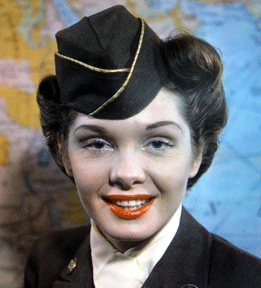
On July 3, 1943, the bill to convert WAACS into WACS passed, with pay, privileges, and protection equal to that accorded to men, and within a month the first battalion of WACs to reach the European Theater of Operations (ETO) arrived in London. 557 enlisted women and 19 officers were assigned duty with the Eighth Air Force. (The Air Forces had obtained about 40 percent of all WAACs in the Army.) A second group arrived in London between September 20 and October 18. On July 14, 1944, the first forty-nine WACs arrived in Normandy, France.
Their spirits were high because of the importance of their work and also it kept up morale. WAC soldiers filled numerable jobs in various conceivable posts, from grimy ordnance to the clean medical and complex chemical warfare departments; overall some 235 different classes of military jobs.
The first WAC training camp in the nation was located at Fort Des Moines, Iowa; Iowa the Hawkeye State whose motto is “Our liberties we prize and our rights we will maintain.” Other WAC training camps opened in Georgia, Massachusetts and Louisiana. Commanded by Colonels Oveta Hobby and Westray Boyce—WACS 150,000 strong—became translators, photo interpreters, B-17 chart plotters, switchboard operators, chauffeurs, secretaries, postal censors, and weather experts, just to name a few. They were Hobby’s spark plugs. Of the over 150,000, 17,000 served in the ETO with about 300 WACs in Supreme Headquarters, Allied Expeditionary Force (SHAEF); 5,500 in North Africa, Asia, the Middle East and the Americas. In the Pacific, WACs and Army nurses were put behind barbed-wire compounds, except when escorted by armed guards to work (or to some approved recreation). The heat and humidity of the tropics caused a jump in the number of evacuations due to health reasons; got so acute it jumped from 98 per thousand to 267 per thousand. Dermatitis was a leading cause. The malaria rate for women was high, as WACs lacked lightweight and proper uniforms. A battalion of black WACs received its long awaited overseas assignment in February 1945. Organized as the 6888th Central Postal Battalion and commanded by Maj. Charity Adams, these 800 WACS were stationed in Birmingham, England, for three months, moved to Rouen, France, and then Paris. The battalion was responsible for the redirection of mail to all U.S. personnel in the ETO. Like to explore some more? Check this link out, includes a mention on historic parks. Sixteen women received the Purple Heart. Sixty-two WACs received the Legion of Merit. The Bronze Star was awarded to 565 WACS for meritorious service overseas.
The American WAVES
They were also created in ’42.
By 1945, they would be 87,000 strong, the WW II peak.
The WAVES in their deep blue and white uniforms or khaki and white held a variety of jobs.
Some of their duties were accountants, receptionists, draftsmen, librarians, secretaries, artists, chemists, chauffeurs, physicists, radio-handlers, control-tower operators, film projectionists, cryptographers, telegraph and teletype operators, and most importantly medical specialists, especially as the war drew to a close. How good it is to speak of war's end, but in the beginning many hearts entered the realm of the dead, most especially for Americans who fought in the Pacific. Beneath a WAVE cartographer are 4 b-w photos, naval vessels were hit or sunk while trying to stop the Japanese reinforcements (Tokyo Express) off Guadalcanal. 1. Carrier Hornet Oct. 28 before sinking. 2-3. The damaged Minneapolis and New Orleans after the 4th Battle of Savo Is. Nov 30-Dec1, 1942. Night engagements the heavy cruiser Northampton fought, but was hit by 2 torpedoes and sank several hours later about 10 miles from Savo Is. It is aka The Battle of Tassafaronga; Northampton had participated (Apr. 18, 1942) in the Doolittle Raid. 4. Doolittle is 2nd from L. In color is Savo Is. To the WW II generation, they were avid reminders that the war was not easy fighting for breaths of victory. The WAVES director was Lieutenant Commander Mildred H. McAfee, former President of Wellesley College. WAVES received the same pay as men. Also, off Guadalcanal another U.S. carrier went to the deep, but in September, the Wasp.




The American Army Nurse Corps

#1
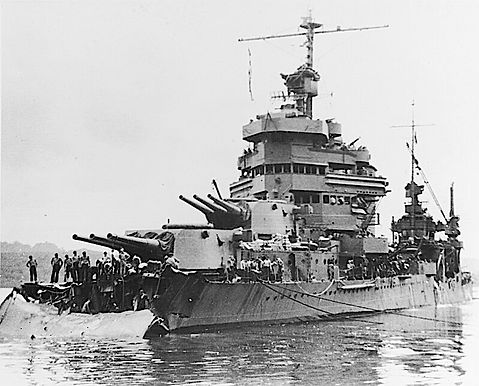
#2

#3
#4

The next largest group were the Army Nurse Corps. Uniformed Army style, wherever America went, and that means anywhere from frigid Alaska to the tropical Solomons, the members of the Army Nurse Corps showed up with their healing skills. When Pearl Harbor was attacked, we had less than 1,000 Army nurses, but 6 months later, the number of women enlisted as nurses increased to 12,000.
Needless to say, sometimes even paying the price with their own lives for being so close to the action. We see Army nurses receiving refreshments from a Red Cross worker on their way to the Frontlines.
Rugged conditions under which the Army Nurse Corps were exposed, 59,000+ strong, called for the training of foxholes, the understanding of gas defense, the purification of water in the field, and generally the getting accustomed to the necessity of crawling, crawling and to crawl some more. They had to get used to it in the rain and sticky mud, under barbed wire burdened with medical supplies.
They also had to do a 20-mile hike. Only 479 black nurses were allowed. 201 Army nurses gave up their lives during WW II. Many women of all services received gallant Silver Stars, Meritorious Commendations, Air Medals, Purple Hearts. Some who received the Silver Stars and Purple Hearts were nine Army nurses who kept on working at a field hospital area on the bombarded beachhead at Anzio, Italy, with the Fifth Army. Six of the nine never even left Anzio alive. 16 Army Nurses died as a result of direct enemy fire. Overall, 1,600 Nurses received medals, but 201 Army Nurses made a trip in a coffin.
The Army used the power of aviation and instituted a new job for nurses. Air evac units airlifted casualties from the front lines. It is said of every 100,000 wounded evacuated by this unit, only 5 died during the flights. In addition to the medical care during the war, after the conflict ended, their service was extended to the millions of tragically displaced persons who were forced to leave their homes in Europe, the Mediterranean or Asia.
In protective helmet, a nurse on the field in Normandy, France. U.S. troops were stymied by German reinforcement around Periers, St. Lo and La Haye-du-Puits. Fighting in the hedgerows of France was devoid of humor. On July, 8, 1944, 3 U.S. divisions reached the latter with casualties of about 5,000. In another objective, Lessay, within the following week, another 5,000 casualties resulted. The battles of Korea and Viet Nam seem relatively unimposing when compared to the Battles of Normandy. Tent hospital personnel in back of the lines received no rest. Their story can be found in the lavishly, illustrated 1944 hardcover commemorative book A Toast For You and Me, America's Participation, Sacrifice and Victory. This is a rare glimpse of a D-Day and Battle of the Bulge Army nurse veteran Marcella LeBeau, a 100-year old Native American of the Great Sioux Nation.
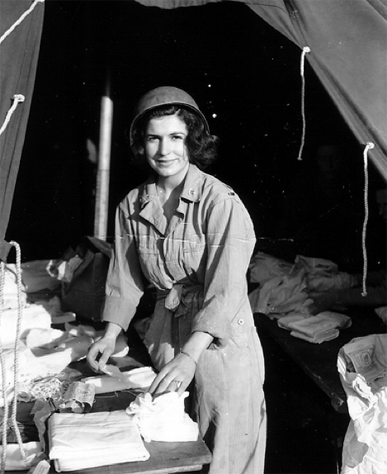



The strangely evil pulse of a world wide war was unending, dramatic, and awesome The years 1941-1945 meant a military setting, with campaigns as utterly profane and different as the lands they were fought in. And, with the increased American participation came increased wounded and casualties. Above, we see the stretchers being pulled out of a hospital train and to be taken to a hospital by ambulance. Notice the body of the ambulances, this is what is part of the tapered streamline age. Curved, round edges.
The American Woman Marines
The trimly clad members of the U.S. Marine Corps Women's Reserve were affectionately dubbed, “Lady Leathernecks.” Women in the Marines received the same pay as men, when permitted to do the same jobs done in the line of duty. Some 19,000 “Lady Leathernecks” accomplished more than 150 important types of military jobs at more than 50 Marine bases. Women Marines learning to handle communications. They learned morse code, and code sheets. Corporal Dorothy C. Ennis of NJ at the control board, Miami University in Ohio.

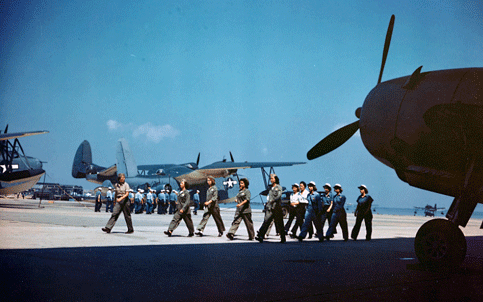
Organized February 13, 1943, directed by Lt. Col. Ruth Cheney Streeter, women marines were thoroughly subjected to harsh boot camp just like the male marines. Women Marine mechanics marching alongside Navy WAVES. Aircraft in the picture include PBM flying boats, a TBM torpedo plane, dark foreground, and just below propellers is an OS2U floatplane to the right.

The American Navy Nurses
The next largest group were the Navy Nurse Corps.
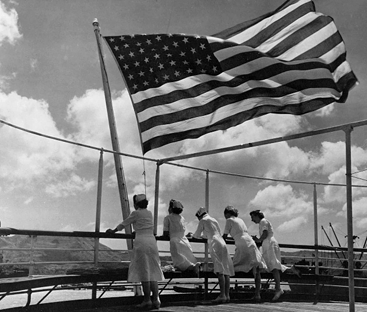
Months before Pearl Harbor, as many Americans were being evacuated from most of the Pacific Islands, heroic Navy nurses chose to remain; the substance of what they did is avidly described in this 23 min video. Established in 1908 as an integral part of the Navy, when the Philippines and Bataan fell in 1942, 11 Navy Nurses wound up as POW’s in Japanese prisoner camps; and it was through them, that countless people did not “fold over” and die. On July 31, 1945, the total of Navy Nurses on duty was 11,021, in 40 naval hospitals and on board 12 hospital ships. Flight Nurse Ensign Miriam R. Serrick of N. Carolina (below) fills syringe with penicillin prior to injection on an air evac transport.

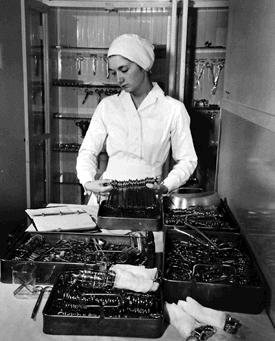
A little aspect of nursing, picking the instruments for surgery at a U.S. Naval hospital and sorting them to be ready. We see Navy nurse I.M.Harrod at the Naval Hospital at Oakland, California.
The American SPARS
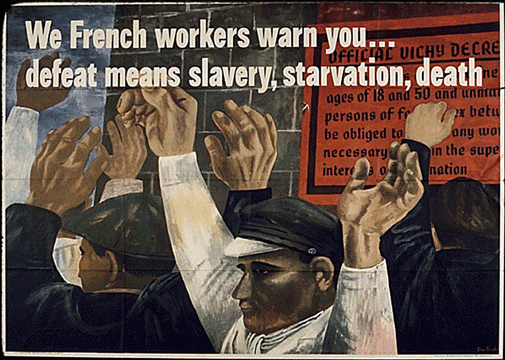
Captain Dorothy C. Stratton, from Purdue University, became director of the SPARS, women’s reserve Coast Guard.
SPARS is an acronym taken from the letters of the Coast Guard motto and translation: SEMPER PARATUS—Always Ready.
By nineteen forty-four, over 10,000 American women were on active duty in fields ranging from cooks and PX storekeeper to aviation operators and communications. SPARS trained at the largest Coast Guard training center which was in Manhattan, New York.
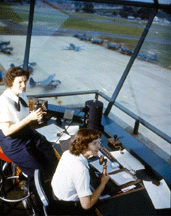

The American WASPS
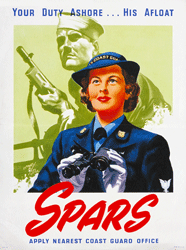
Practically flying every conceivable kind of aircraft used by the Army Air Force—in WW II it was known as such—ranging from the A-20’s to the Superfortress to the P-51 Mustangs, the women in WASP (Bee) flew enough miles to complete a trip around the world exactly 2,500 times at the equator.
The Women Air Force Service Pilots, WASP, was activated in the summer of 1943. This program, strictly home front, was a culmination of two previous ones. The original women pilots were activated in September of 1942 in two steps. The first was the formation of an experimental squadron of experienced women pilots to do ferry work in the Air Transport Command—under the Women’s Auxiliary Ferrying Squadron, dubbed the WAFS. They ferried new arircraft from factories to military bases. And, the other step was an initiation of a training program for women pilots who would do what the WAFS did not do, like transporting military personnel and cargo or flight engineer tests. Both programs worked independent of each other, until August of 1943. In November 1977, President Carter signed a bill granting WW II veterans’ status for former WASPs. In 2009, any surviving WASP was awarded the Congressional Gold Medal. A WASP was lucky if an assignment took her to a beach and was able to meet male pilots and other servicemen.

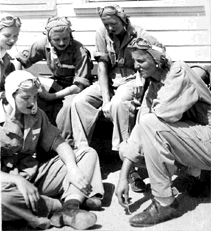

On the job sometimes cost them lives. There were 38 serious fatalities. Independent of the military, duties for the high flying WASPs embraced tracking and search-light mission, radio-control flying, target towing, simulated strafing, smoke laying, ferrying, instrument instruction to men, test flying, administration and utility flying. The director was Jacqueline Cochran. Nancy Love was the staff executive. The training program was difficult for the 1,830 young trainees, and at times student fliers were deliberately given rough male instructors; although 25,000 American women applied. But, 1,074 women earned their WASP wings. In using the program as an experiment, it was inactivated December 20, 1944, careful records were kept to determine the physical suitability and stability of women as pilots. Statistics proved that women were as efficient and effective as male pilots in most classes of duty.


Elizabeth L. Gardner WASP pilot at Harlingen, Army Airfield, Texas.
The American Cadet Nurse Corps

The largest of all the women’s international civilian uniformed services formed after the bombing of Pearl Harbor were the U.S. Cadet Nurse Corps.
Created by the Bolton Act which was passed unanimously by Congress in June of 1943, the Corps grew so fantastically, that twenty-four months later there were over 120,000 women as active Cadets.
The appeal of this program was amply proved by the fact that the Corps exceeded its recruitment quota for the two consecutive years of its existence. And, according to the American Hospital Association, the Cadets prevented what would have been a tragedy of major proportions—the collapse of civilian nursing services.
Student nurses, 83% of whom were Cadets, were given more than 80 percent of the patient care in all hospitals with schools of nursing. Under a Nurse Training Bill which was signed into law in 1943 by Congress, it barred racial discrimination in the Cadets. Two thousand nurses were black Cadets. Under the Cadet Nurse program, graduates at the time pledged themselves to remain in essential nursing jobs throughout the war. There is no escape from the realities of war. The Cadet Nurses, key in the middle of the war, kept their bodies strong, their mind alert, their heart steadfast. The Red Cross workers were an independent body composed of both non- and Registered Nurses attached to military hospitals, ships and trains to care for wounded troops; also had the care of Allied POWs. When you see videos of someone giving out coffee and donuts oversees in "Clubmobiles" it was them. Under the auspices of the International Red Cross, the Red Cross handled displaced persons. All the dedicated women who did their part in WW II should never be forgotten. P.S. Men were also in the Red Cross.
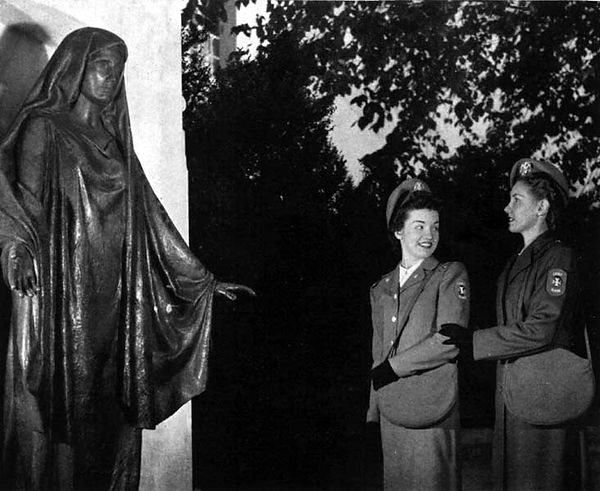





Your information is protected by
256-bit SSL encryption.

The American Women’s Voluntary Services
Created before Pearl Harbor December 7, 1941 the American Women's Voluntary Services was strictly Home Front, it was established in anticipation of the part American women would play in protecting their homes and communities. It eventually grew to over 325,000 women.

Initially established in January of 1940 in Cooperstown, New York based on the work of the Women's Volunteer Services of Great Britain, they volunteered from the little hamlets and towns to the great metropolises. The uniqueness was that it was open to all women, irregardless of race, creed, color or religion. Their motto: UNITE AND SERVE. The organization in the United States was divided into nine regions. There were no dues, strictly non-partisan and non-political. The uniform consisted of both wool and a light weight cotton and rayon material in blue-grey. Four large buttons down the front, epaulets with an AWVS emblem on the upper left sleeve. Tan stockings like the WACS with brown shoes. White blouse with a navy blue tie. Finding photographs from the East Coast to West Coast in color is difficult. Younger women however flocked to war-time jobs because of the pay or other services after December 1941. Nevertheless, they were a very important part of CD, Civilian Defense.

